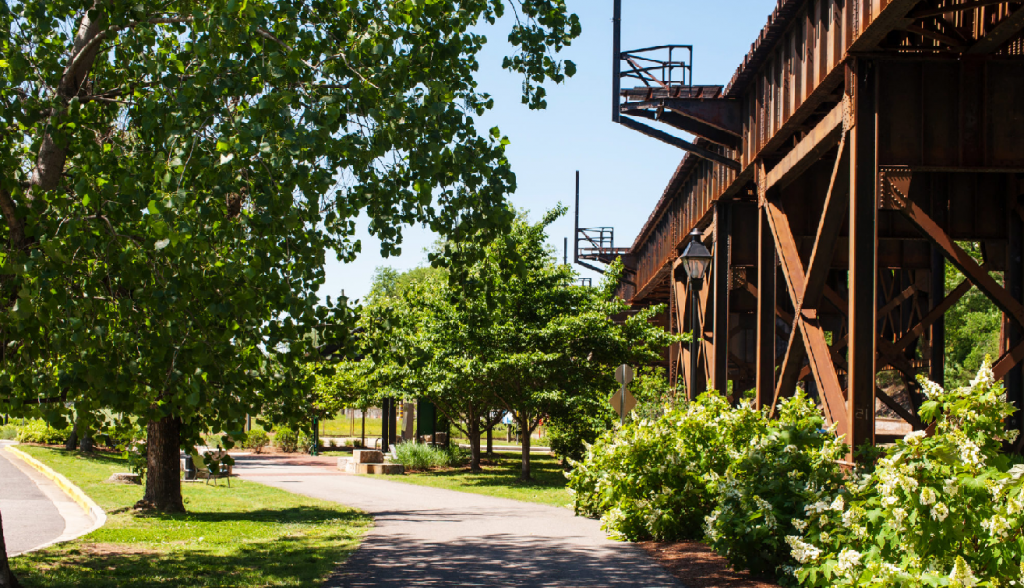By Josh Knoll
This week, members of the NASF Urban and Community Forestry Committee traveled to historic Richmond, Virginia, for the chance to share ideas, plan for the future, and tour successful green infrastructure programs in the area. Several state foresters, state forestry agency UCF coordinators, and private and government-employed arborists came from near and far to discuss our most pressing urban forestry concerns.
The two-day meeting began with a host welcome from Virginia State Forester Rob Farrell and was facilitated by Nebraska State Forester John Erixson, the committee’s chairman, and Keith Wood, the committee’s staff person.
Speakers and Presentations:
- NASF Communications Director Whitney Forman-Cook and Policy Director Robyn Whitney gave national updates, as did Forest Service employees Eric Kuehler, with the Urban Forestry South office, and Jan Davis, the State and Private Forestry Urban and Community Forestry national program lead.
- In his presentation, Washington, D.C. State Forester Earl Eutsler explained how the District is using trees removed from urban areas to make baseball bats and schoolyard equipment. Robert Corletta, UCF coordinator for the District, presented on the Northeast-Midwest State Foresters Alliance’s communication efforts and ongoing initiatives.
- Rachel Ormseth, UCF coordinator in South Dakota, gave an update on urban and community forestry projects in the West.
- Mark Bays, UCF coordinator in Oklahoma, presented on the #HealthyTreesHealthyLives initiative and other Southern Group of State Foresters work, as well as an ongoing project to preserve a tree of special significance on the Oklahoma Capitol lawn.
- Dan Lambe, president of the Arbor Day Foundation, gave attendees a partner update on existing projects run by state forestry agencies and Arbor Day, as well as a preview of forthcoming joint projects.
- Virginia Department of Forestry (VDOF) employee Joe Lehnen touted the state’s Urban Wood Program, which aims to spur local use and enhanced management of urban trees. Lara Johnson and Meredith Bean, also with VDOF, explained the steps the agency took to combat emerald ash borer in the state.
- Bob Benson, the acting chief of the EPA’s Partnership Programs Branch – Office of Water, detailed the agency’s Urban Waters Partnership and 19 current projects.
- Karen Firehock of the Green Infrastructure Center described the Trees to Offset Stormwater program, and laid out the tools the agency used to help cities measure tree cover and assess risk.

The meeting also included a half-day tour of four local green infrastructure projects that are utilizing trees:
- Stop #1: Historic Evergreen Cemetery, where TreeLab (a local urban forestry non-profit) is partnering with the city to fight invasive species, save an overgrown cemetery, and preserve the historic grave sites of prominent African-American citizens and civil rights icons.
- Stop #2: The Low Line, a former floodplain and dilapidated ship loch that has been turned into a thriving park and an economic asset to the city.
- Stop #3: Belle Isle Park, a natural place to recreate in an otherwise urban setting. Originally a Civil War prisoner-of-war camp turned industrial site, volunteers have restored large parts of the island by reforesting and managing invasive species.
- Stop #4: McGuire Veterans Hospital, which transformed an unused, sparsely green back yard into a therapeutic forested area used for rehabilitating veterans.
Josh Knoll is NASF’s 2019 Spring James Hubbard Intern for Policy and Communications. He can be reached by email at intern@stateforesters.org.

